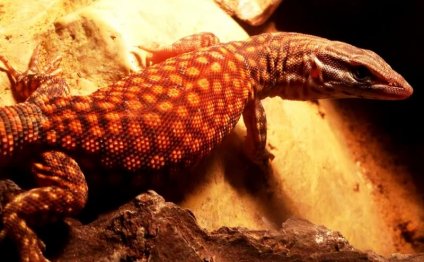
Dwarf monitor lizards
 The Ackies Monitor, also known as the spiny-tailed monitor, ridge-tailed monitor, Ackies dwarf monitor, or by its scientific name Varanus acanthurus, is one of the most popular monitor lizards for exotic pet owners. Found throughout much of Australia (and especially in arid regions or scrubland environments throughout Western Australia, Northern Territory, and parts of Queensland), these monitors are known for being inquisitive and active. These behavioral traits, as well as their fascinating colors and patterns and relatively small size, make them a favorite among reptile enthusiasts. If you’ve recently acquired an Ackies monitor, this article will go over the proper way to care for your lizard and ensure its safety and longevity.
The Ackies Monitor, also known as the spiny-tailed monitor, ridge-tailed monitor, Ackies dwarf monitor, or by its scientific name Varanus acanthurus, is one of the most popular monitor lizards for exotic pet owners. Found throughout much of Australia (and especially in arid regions or scrubland environments throughout Western Australia, Northern Territory, and parts of Queensland), these monitors are known for being inquisitive and active. These behavioral traits, as well as their fascinating colors and patterns and relatively small size, make them a favorite among reptile enthusiasts. If you’ve recently acquired an Ackies monitor, this article will go over the proper way to care for your lizard and ensure its safety and longevity.
Behavior
In the natural world, Ackies monitors live in humid burrows near rocky outcroppings; they dig their burrows deep in order to escape the oppressive Australian heat, as well as to create a controlled environment with the proper humidity and temperature for the lizards. When frightened, they will retreat into crevices, puffing up their bodies to wedge themselves into the spaces between rocks. Although they are known as “dwarf” monitors (in comparison to other monitor lizards such as the Komodo dragon, which can grow up to 10 feet long), Ackies monitors are not actually very small, reaching an average length of 24-28 inches. Males are usually larger than females, and the tail is about 1.3-2.3 times longer than the head and body. They are widely known for the yellowish-cream spots on their dark brown backs, which stand out in unique patterns, as well as pale longitudinal stripes on their necks. If properly cared for, Ackies monitors can have an average lifespan of 15-20 years.
We are able to suggest Industrial Design of lighting.
Housing
Ackies monitors are a very active species, which means that they need proper amounts of room to hunt, explore, bask, and burrow. A tall cage is always recommended, because of the room needed for a deep substrate that they can burrow in. A glass terrarium, at least twice the length of the lizard (with variable breadth and depth), is the standard, although it is always better to provide more room than less. A thick and moist substrate layer of earth, coconut beddings, or cypress chip bedding is key - Ackies monitors need to stay hydrated in order to survive. To this end, you should also provide a water bowl large enough for the lizard to soak itself in, and mist the cage twice a day to help maintain moisture levels. When furnishing the habitat, it is also important to create numerous hiding spots for the lizard - cork bark stacks, half logs, flat pieces of wood, thick layers of bedding and moss, caves, and fake plants all provide opportunities for Ackies monitors to hide and stay warm.
Heating and Lighting
As cold-blooded creatures, Ackies monitors need adequate heating and lighting in order to survive. Ackies monitors are basking lizards, which means that they need UVB rays in order to stay healthy (UVB helps them make Vitamin D3, which aids the absorption of calcium and helps avoid metabolic bone disease). Therefore, make sure to provide a lamp that supplies them with enough UVB rays, as well as the necessary heat, in one bulb. A basking zone of around 120 degrees, with the cooler side no lower than 65 degrees and no warmer than 80 degrees, is closest to the lizard’s natural Australian habitat. Furthermore, it is important to keep the Ackies monitors on a 12-hour cycle by switching off the lamp at night (you can do this manually or on a timer). Ceramic heat emitters can help you achieve the proper temperature if lamps are not doing enough.
Feeding
Ackies monitors have been known to eat a range of foods, including mice, crickets, hissing cockroaches, mealworms, canned food diets, snails, eggs (chicken, quail, and leopard gecko), and shrimp. However, not all possible food is good food; instead, experts recommended feeding your monitor a diet consisting of almost entirely whole prey foods, with a small portion of raw turkey and egg. Prey foods include hissing cockroaches, dubia roaches, lobster roaches, crickets, and mealworms, which should all be dusted with calcium and/or vitamin powder for maximum nutrition. You can also add mice to the diet, as long as they are weaned - also avoid feeding your monitors rodents in excess. Young monitors should mostly be kept on a diet of crickets, mealworms, and small roaches, as they cannot yet swallow the larger prey.
RELATED VIDEO



Share this Post
Related posts
Colorful lizard
A very large species of chameleon that is endemic to forests in eastern and northern Madagascar. They reach up to 68 cm (27…
Read MorePet monitor lizards
Monitors are hardy lizards that can live long and happy lives. By supplying your monitor with proper care, food, habitat…
Read More











